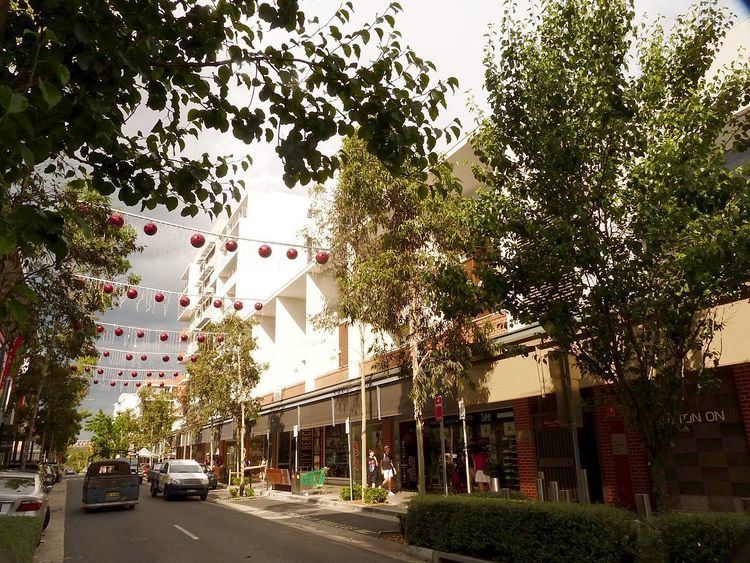Population 7,482 (2011 census) Postcode(s) 2155 Founded 1802 Local time Thursday 9:01 PM | Established 1802 LGA(s) The Hills Shire Postal code 2155 | |
 | ||
Location 42 km (26 mi) north-west of Sydney CBD State electorate(s) Castle Hill, Riverstone Weather 19°C, Wind S at 13 km/h, 93% Humidity Federal divisions Division of Greenway, Division of Mitchell | ||
Rouse Hill is a suburb of Sydney, in the state of New South Wales, Australia. With a population of 7,482 Rouse Hill is located 42 kilometres north-west of the Sydney central business district in the local government area of the City of Blacktown and The Hills Shire. Rouse Hill is part of Greater Western Sydney and is in the Hills District.
Contents
- Map of Rouse Hill NSW 2155 Australia
- History
- Rouse Hill House
- Commercial area
- Churches
- Education
- Transport
- Demographics
- References
Map of Rouse Hill NSW 2155, Australia
History
Rouse Hill encompasses what was originally known as the Village of Aberdour along with the area originally known as Vinegar Hill following the convict rebellion of 1804. Vinegar Hill Post Office opened on 1 October 1857 and was renamed Rouse Hill on 13 April 1858. The new name was chosen after the estate of Richard Rouse (1774-1852), a prominent free settler who arrived in the colony in 1801. His first grant here was in 1802 and his second grant was in 1816. Governor Lachlan Macquarie suggested the estate be called Rouse Hill.
Rouse Hill is noteworthy in Australian history as the site of the main battle during an Irish rebellion, known as the Castle Hill rebellion or the second Battle of Vinegar Hill. On 4 March 1804, Irish convicts including political prisoners transported for participating in the Irish Rebellion of 1798, broke out of the Government Farm at Castle Hill, aiming to seize control of the area and to capture Parramatta. The uprising was crushed by the military authorities at Rouse Hill the following day with much loss of life. Many of the participants in the rebellion were summarily executed. The exact site of the Battle is uncertain but a monument with a plaque commemorating the event can be seen within Castlebrook Lawn Cemetery on Windsor Road in Kellyville Ridge.
Rouse Hill House
Richard Rouse built his home, Rouse Hill House, from 1813-18. Service wings and an arcaded courtyard were added circa 1863. The simple, geometric layout of the garden is probably the oldest surviving in Australia. The house, its immediate surviving estate and outbuildings including stables designed by John Horbury Hunt, is now a house museum cared for by the Historic Houses Trust of New South Wales, and is on the Register of the National Estate.
Much of the family memorabilia has been preserved, including dolls, clothes and writings of the two girls, Nina (1875-1968) and Kathleen Rouse (1878-1932). These form a unique and fascinating record of late-Victorian Australian childhood, and inspired Ursula Dubosarsky's prize-winning novel "Abyssinia".
Commercial area
Rouse Hill Town Centre built on the old golf course is a new town centre, owned and managed by The GPT Group, is located at the intersection of White Hart Drive and Windsor Roads. The first stage opened in September 2007 with the launch of the town centre on 6 March 2008. The first stage comprises Woolworths and Coles supermarkets, a food terrace, and 80 specialty stores . The second stage comprises Big W, Target, Reading Cinemas, an additional 130 specialty stores, a Community Centre, Library, Medical Centre, commercial and residential accommodation and the Secret Garden. The development has been integrated with the North-West T-way with provisions made for the proposed North West Rail Link.
Rouse Hill Village Centre which opened in 1999, is a small shopping centre located on Windsor Road. This complex features a major discount supermarket chain selling packaged groceries and perishables, as well as specialty shops and restaurants. The Terrace is another small shopping centre which was opened on Panmure Street in 2004.
Churches
Education
Transport
Rouse Hill is bisected by Windsor Road, which is now a major 4-lane road running from North Parramatta north-west to Windsor. Most residents of Rouse Hill are reliant on private cars for transport, with a high number of households having two or more cars.
Hillsbus provides services to Sydney CBD, North Sydney, Parramatta, Macquarie Park and Castle Hill, whilst Busways provides services to Blacktown, Riverstone and Castle Hill. Hillsbus also provides weekday services from Rouse Hill to Windsor. In September 2007 the North-West T-way opened, providing a bus rapid transit service to Parramatta railway station.
The North West Rail Link is a proposed railway line running from Rouse Hill to Epping, where it will connect to the existing Epping to Chatswood railway line.
Demographics
At the 2011 census, the suburb of Rouse Hill recorded a population of 7,482 people. Of these:
